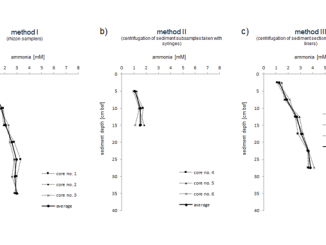
Paper category: Original research paper
Corresponding author: Katarzyna Łukawska-Matuszewska (k.lukawska@ug.edu.pl)
DOI: 10.1515/ohs-2018-0026
Received: October 9, 2017
Accepted: March 5, 2018
Full text: here
Citation (APA style):
Abstract
The impact of 2014 Major Baltic Inflow (MBI) on ferrous iron (FFe(II)) and phosphate (FPO43−) benthic fluxes was investigated. Sampling took place few months after the MBI, in August 2015, and over one year after the inflow, in February 2016. Materials were collected from three sites (depth of 106–108 m) located in the Gdańsk Deep. Total dissolved iron, Fe(II), phosphate, H2S and sulfate were analyzed in bottom and pore water. Benthic fluxes were estimated using Fick’s first law. All fluxes were directed from sediment. FFe(II) ranged from 0.31 × 10−2 to 1.25 × 10−2 µmol m−2 hr−1 and FPO43− from 1.53 to 2.70 µmol m−2 hr−1. At the deepest site, FFe(II) was similar in both seasons, while at two other sites fluxes in August 2015 were 40–50% smaller than in February 2016. The increase in bottom water oxygen after the MBI enhanced Fe(oxyhydr)oxides formation. As a consequence, bottom and pore water concentrations of Fe(II) and FFe(II), decreased. Adsorption of phosphate onto Fe(oxyhydr)oxides resulted in binding of P in surface sediment and lower FPO43− in August 2015. This was particularly evident at the shallowest site. The reductive dissolution of Fe(oxyhydr)oxides and desorption of P during the subsequent months resulted in higher FPO43− in February 2016.




Bądź pierwszy, który skomentuje ten wpis